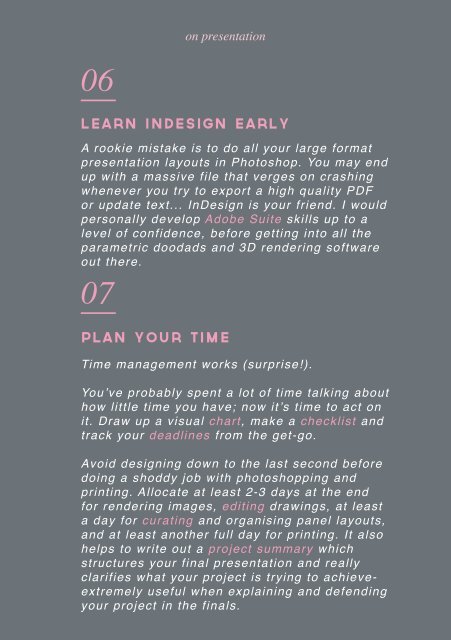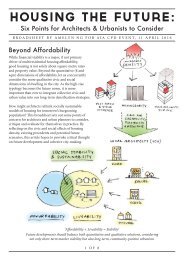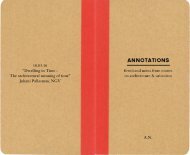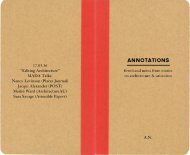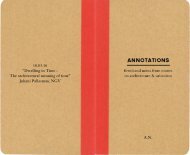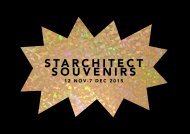Notes for New Students
A Practical Guide to Architecture School
A Practical Guide to Architecture School
You also want an ePaper? Increase the reach of your titles
YUMPU automatically turns print PDFs into web optimized ePapers that Google loves.
06<br />
on presentation<br />
08<br />
on presentation<br />
learn indesign early<br />
try not to read off a script<br />
A rookie mistake is to do all your large <strong>for</strong>mat<br />
presentation layouts in Photoshop. You may end<br />
up with a massive file that verges on crashing<br />
whenever you try to export a high quality PDF<br />
or update text... InDesign is your friend. I would<br />
personally develop Adobe Suite skills up to a<br />
level of confidence, be<strong>for</strong>e getting into all the<br />
parametric doodads and 3D rendering software<br />
out there.<br />
07 09<br />
Based on the sheer amount of quality time one<br />
spends with their design project over semester<br />
alone, I would honestly advise losing the palm<br />
cards on presentation day. You don’t want to be<br />
looking down, misreading lines and looking unsure<br />
about your design when deep down you know every<br />
aspect by heart. Take time to practise in an empty<br />
room the day be<strong>for</strong>e and put visual cues in your<br />
drawings that enable you to talk to the work.<br />
plan your time<br />
Time management works (surprise!).<br />
You’ve probably spent a lot of time talking about<br />
how little time you have; now it’s time to act on<br />
it. Draw up a visual chart, make a checklist and<br />
track your deadlines from the get-go.<br />
Avoid designing down to the last second be<strong>for</strong>e<br />
doing a shoddy job with photoshopping and<br />
printing. Allocate at least 2-3 days at the end<br />
<strong>for</strong> rendering images, editing drawings, at least<br />
a day <strong>for</strong> curating and organising panel layouts,<br />
and at least another full day <strong>for</strong> printing. It also<br />
helps to write out a project summary which<br />
structures your final presentation and really<br />
clarifies what your project is trying to achieveextremely<br />
useful when explaining and defending<br />
your project in the finals.<br />
present with credibility<br />
Make sure your work is logically sequenced, with<br />
an easy-to-follow narrative, so that your audience<br />
arrives at the same conclusions and epiphanies as<br />
you. While it is difficult to present like an ‘expert’<br />
in the field as a student, use all the research you<br />
have to back up the project on your own terms.<br />
10<br />
remember the little things<br />
Include a scale bar with all your drawings, and<br />
make sure your photoshopped people are not<br />
weirdly enormous. Run a spell check. Make a<br />
model that isn’t overly fiddly or prone to collapse.<br />
Don’t give your crits any chance to be distracted!


